What is a tyre label?
As of 01/05/2021, the European tyre label has changed significantly on the basis of updated, stricter European regulations (Regulation (EU) 2020/740). This new European tyre label applies to passenger car tyres (C1), light truck tyres (C2) and heavy truck tyres (C3).
However, the label only lists 5 performance criteria when there are actually 50 performance criteria for assessing the quality of a tyre. For example: wear resistance (mileage), braking on dry surfaces, traction on snow, lateral grip on ice, vehicle noise, handling and aquaplaning.
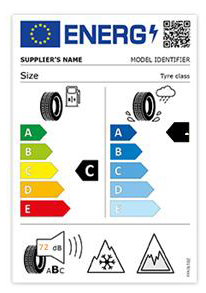
The 5 performance criteria tyre label information
The tyre label provides a value (class) for the following five criteria:
5 classes from A (most efficient) to E (least efficient).
The fuel consumption of a vehicle depends on factors such as the engine type, speed, road surface, weather conditions, etc. Tyre rolling resistance accounts for around 20% of fuel consumption. Less fuel consumption means lower fuel costs and less CO2 emissions.
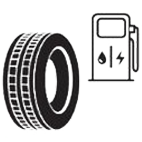
5 classes from A (shortest braking distance) to E (longest braking distance).
The wet grip performance of a tyre can vary depending on the vehicle type, weather conditions and tread pattern, among other factors. Good grip is important for safety.
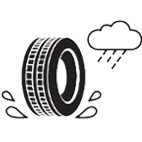
3 classes of external rolling noise, with the measured value in dB.
External rolling noise means the traffic noise caused by the tyre. In addition to the noise level in decibels (dB), the pictogram also indicates the noise level A, B or C.
Note: There is no direct link between external (outside the car) and internal (inside the car) tyre noise.
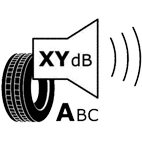
Tyres marked with the snow symbol are deemed to fulfil the minimum snow grip index values as specified in UNECE Regulation No 117 and are suitable for use in severe snow conditions. The snow symbol can be found on winter tyres and many all-season tyres.
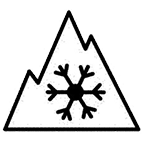
Tyres with the ice symbol satisfies the relevant minimum ice grip index values and are suitable for use in very snowy and icy conditions.
At present, the ice symbol can only be found on labels for passenger car tyres.

The EU has a European Product Database for Energy Labelling (EPREL). The tyre (label) data in the database can be consulted as of 1 May 2021. The new tyre label will also contain a QR code with which the data from the product information sheet, as referred to in Annex III of Regulation (EU) 2020/740, will eventually be available to everyone.
With reference to the aforementioned European Regulation (EU) 2020/740, we emphasise that driver behaviour is the primary determinant of fuel consumption and road safety, and in particular that:
- Ecologically responsible driving can significantly reduce fuel consumption;
- Tyre pressures should be checked regularly to optimise fuel efficiency and wet grip;
- The following distances should always be strictly observed.
This regulation does not apply to:
- Off‐road professional tyres;
- Tyres designed to be fitted only on vehicles registered for the first time before 1 October 1990;
- T‐type temporary‐use spare tyres;
- Tyres whose speed rating is less than 80 km/h;
- Tyres whose nominal rim diameter does not exceed 254 mm or is 635 mm or more;
- Tyres fitted with additional devices to improve traction properties, such as studded tyres;
- Tyres designed only to be fitted on vehicles intended exclusively for racing;
- Second‐hand tyres, unless such tyres are imported from a third country.
Source: Regulation (EU) 2020/740 of the European Parliament and of the Council.
